- 4,803

- Dearborn, MI
- MotorCtyHamilton
If you have read my advanced tuning guide you may have noticed that I ranked camber pretty low on potential for tuning speed and lap time gains. I just havent been able to find much difference in speed between wide ranges of settings. I do think that I feel a difference in grip or stability which seems to produce more consistent lap times, but not speed.
I have also read many differing theories about camber in GT5. Low camber provides more grip. Camber causes tire wear. Lower camber shortens stopping distances. I have yet to see any valid test results posted to support these theories. If I have missed some key test results, please post a link in this thread and I will stand corrected. Nomis3613 has made an effort, but I would call it a good start. Here is a link to his test results.
https://www.gtplanet.net/forum/showthread.php?t=223328
https://www.gtplanet.net/forum/showthread.php?t=201492
The thing that bothers me about the low camber theories is that they seem to be optimizing camber for the straights and the braking zones. In real life racing, thats not the role of camber. Camber is used to get a flat contact patch in the corners. There is far more surface area around a road course in the corners than in the straights. G-forces against the tires are also far greater mid-corner than when driving on straights or in braking zones. Tires arent rocks they will form to the road when the car is going straight. Stand on a soccer ball this is the affect I am talking about. A tire with a large amount of negative camber can handle the g-forces the tire will see in straight line torque and braking. Look at the photo below and you will see a good shot at mid corner camber behavior. Notice how the outside tires are standing almost straight up and there is a nice full contact patch across most of the front and rear tires, yet a bit of air can be seen under the inside front tire. This is optimized camber in the real world.
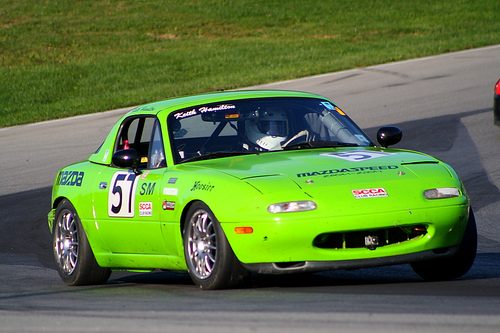
I know, I know GT5 is not real life and PD may not have programmed tuning to match the real world. So, with these thoughts in mind, I wanted to build a repeatable test and post some first results. As I have time, I will add to this thread with additional cars and tire compounds. Below is the methodology that I used for this first test.
Top Gear Test Track, online, fuel & tire wear on, grip reduction real, sport soft tires. The Top Gear Test Track has so many good markers across the track that it makes for perfect grip comparisons. Plus, I like this track and know it very well, so there was no learning curve involved that would affect lap times. I also chose a car that has been tuned to my driving style and has a nice, fast balanced online tune. The car is the Honda S2000 06 from the premium dealership with 450PP I will post full tune later tonight. I ran five laps with each camber setting looking for the fastest overall lap time as well as speed in MPH at six different sector locations. I ran seven different camber settings ranging from zero/zero to 3.5/3.5. I kept front/rear the same in an effort to keep the front/rear balance of the car the exact same through the test. I ran the settings in random order (i.e., 2.0 then 1.0 then 3.5 then 0.0, etc.) in an online race against myself and simply saved the replays for later analysis. This turned out to be a good way to test because I didnt really know how the results were playing out until the final analysis of watching the replays. I think that kept bias out of the results.
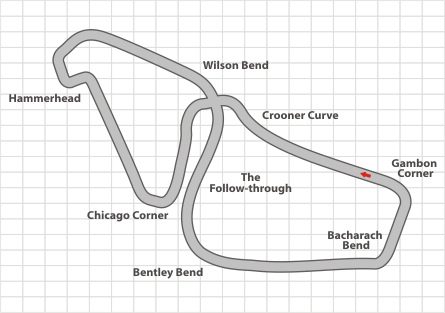
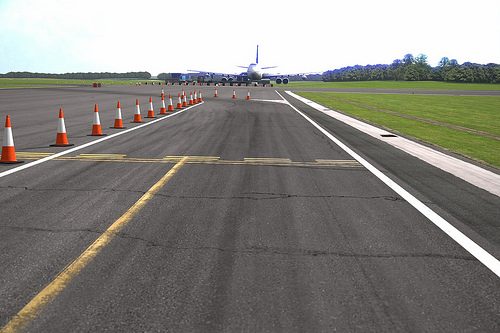
Sector one: After Crooner Curve in the short straight next to the line of cones there is a yellow line with a red airport marker to the left reading 25-07.
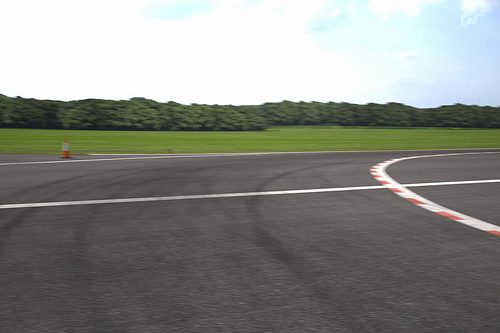
Sector two: Chicago Corner at the white line that crosses the track right at the apex.
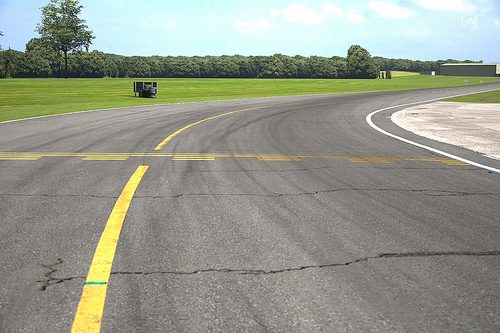
Sector three: After Hammerhead measured at the first yellow stripe across the track as the corner is unwinding. There is a red airport sign that can be read if driving the track in the opposite direction that shows 07.
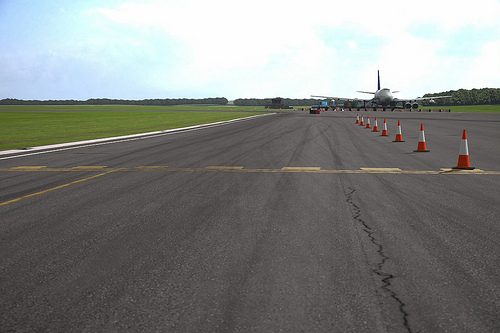
Sector four: After Wilson Bend into the Follow-Through next to the line of cones there is a yellow line with a red airport marker way to the left reading 25-07.
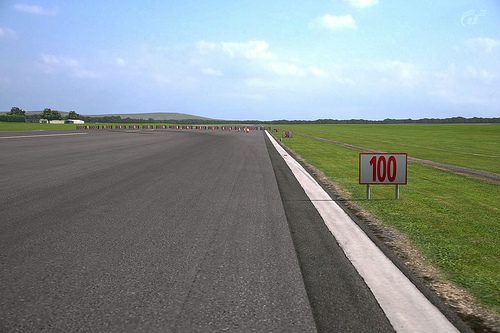
Sector five: After Bentley Bend and down the longest straight at the 100 meter braking marker.
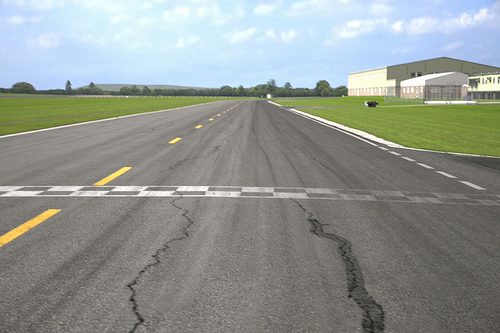
Sector six: After Bacharach Bend and Gambon Corner I measured at the start/finish stripe.
Results (best MPH at each sector and fastest lap):

Hmmm seemingly this was a colossal waste of time. All times within 0.9 seconds of each other. No real pattern developed meaning I dont see a bell curve across the camber range. The MPH ranges do indicate that some camber settings can provide a small gain is some corners, but be behind in others. Also, the data did not show what I was feeling in the car. Lower settings definitely slid around more and produced more red tires when pushed just a little over the edge. With 0.0 I turned three tires red in Bacharach Bend where 2.0 was only the outside front. I was also less consistent with settings 2.0 and below. The sweet spot for me was 2.5 and 3.0, based on feel, but I am not happy with such small lap times and MPH gains.
So what have I proven? In my mind, the only thing that I have proven is that more testing is needed from the GTP tuning community before we truly know which camber settings are best. This was a very controlled test with one car on one compound of tire at a lower PP level. Maybe we would see more gains with harder tires, more power, something? I am open to suggestions.
As I think a little more deeply about this test, I do come to one conclusion that I can stand firm upon. PD did a lousy job of programming camber in GT5. It is such an important setting in the real world yet seems to matter so little in GT5. They provide no tools to help optimize camber. I would love to have tire temps across the tire as I do in real life. I am beginning to believe that the reason that GT5 has such a lack of tools available to optimize camber is that it truly is just a blip in the physics model. Because of this, I will continue to offer the advice to newbies, that if you want to get fast quick in GT5, learn to tune the LSD.
I have also read many differing theories about camber in GT5. Low camber provides more grip. Camber causes tire wear. Lower camber shortens stopping distances. I have yet to see any valid test results posted to support these theories. If I have missed some key test results, please post a link in this thread and I will stand corrected. Nomis3613 has made an effort, but I would call it a good start. Here is a link to his test results.
https://www.gtplanet.net/forum/showthread.php?t=223328
https://www.gtplanet.net/forum/showthread.php?t=201492
The thing that bothers me about the low camber theories is that they seem to be optimizing camber for the straights and the braking zones. In real life racing, thats not the role of camber. Camber is used to get a flat contact patch in the corners. There is far more surface area around a road course in the corners than in the straights. G-forces against the tires are also far greater mid-corner than when driving on straights or in braking zones. Tires arent rocks they will form to the road when the car is going straight. Stand on a soccer ball this is the affect I am talking about. A tire with a large amount of negative camber can handle the g-forces the tire will see in straight line torque and braking. Look at the photo below and you will see a good shot at mid corner camber behavior. Notice how the outside tires are standing almost straight up and there is a nice full contact patch across most of the front and rear tires, yet a bit of air can be seen under the inside front tire. This is optimized camber in the real world.

I know, I know GT5 is not real life and PD may not have programmed tuning to match the real world. So, with these thoughts in mind, I wanted to build a repeatable test and post some first results. As I have time, I will add to this thread with additional cars and tire compounds. Below is the methodology that I used for this first test.
Top Gear Test Track, online, fuel & tire wear on, grip reduction real, sport soft tires. The Top Gear Test Track has so many good markers across the track that it makes for perfect grip comparisons. Plus, I like this track and know it very well, so there was no learning curve involved that would affect lap times. I also chose a car that has been tuned to my driving style and has a nice, fast balanced online tune. The car is the Honda S2000 06 from the premium dealership with 450PP I will post full tune later tonight. I ran five laps with each camber setting looking for the fastest overall lap time as well as speed in MPH at six different sector locations. I ran seven different camber settings ranging from zero/zero to 3.5/3.5. I kept front/rear the same in an effort to keep the front/rear balance of the car the exact same through the test. I ran the settings in random order (i.e., 2.0 then 1.0 then 3.5 then 0.0, etc.) in an online race against myself and simply saved the replays for later analysis. This turned out to be a good way to test because I didnt really know how the results were playing out until the final analysis of watching the replays. I think that kept bias out of the results.


Sector one: After Crooner Curve in the short straight next to the line of cones there is a yellow line with a red airport marker to the left reading 25-07.

Sector two: Chicago Corner at the white line that crosses the track right at the apex.

Sector three: After Hammerhead measured at the first yellow stripe across the track as the corner is unwinding. There is a red airport sign that can be read if driving the track in the opposite direction that shows 07.

Sector four: After Wilson Bend into the Follow-Through next to the line of cones there is a yellow line with a red airport marker way to the left reading 25-07.

Sector five: After Bentley Bend and down the longest straight at the 100 meter braking marker.

Sector six: After Bacharach Bend and Gambon Corner I measured at the start/finish stripe.
Results (best MPH at each sector and fastest lap):

Hmmm seemingly this was a colossal waste of time. All times within 0.9 seconds of each other. No real pattern developed meaning I dont see a bell curve across the camber range. The MPH ranges do indicate that some camber settings can provide a small gain is some corners, but be behind in others. Also, the data did not show what I was feeling in the car. Lower settings definitely slid around more and produced more red tires when pushed just a little over the edge. With 0.0 I turned three tires red in Bacharach Bend where 2.0 was only the outside front. I was also less consistent with settings 2.0 and below. The sweet spot for me was 2.5 and 3.0, based on feel, but I am not happy with such small lap times and MPH gains.
So what have I proven? In my mind, the only thing that I have proven is that more testing is needed from the GTP tuning community before we truly know which camber settings are best. This was a very controlled test with one car on one compound of tire at a lower PP level. Maybe we would see more gains with harder tires, more power, something? I am open to suggestions.
As I think a little more deeply about this test, I do come to one conclusion that I can stand firm upon. PD did a lousy job of programming camber in GT5. It is such an important setting in the real world yet seems to matter so little in GT5. They provide no tools to help optimize camber. I would love to have tire temps across the tire as I do in real life. I am beginning to believe that the reason that GT5 has such a lack of tools available to optimize camber is that it truly is just a blip in the physics model. Because of this, I will continue to offer the advice to newbies, that if you want to get fast quick in GT5, learn to tune the LSD.
Last edited:




 I'll be easy on you tho as I know Adrenaline will be here with his witty comments.
I'll be easy on you tho as I know Adrenaline will be here with his witty comments.